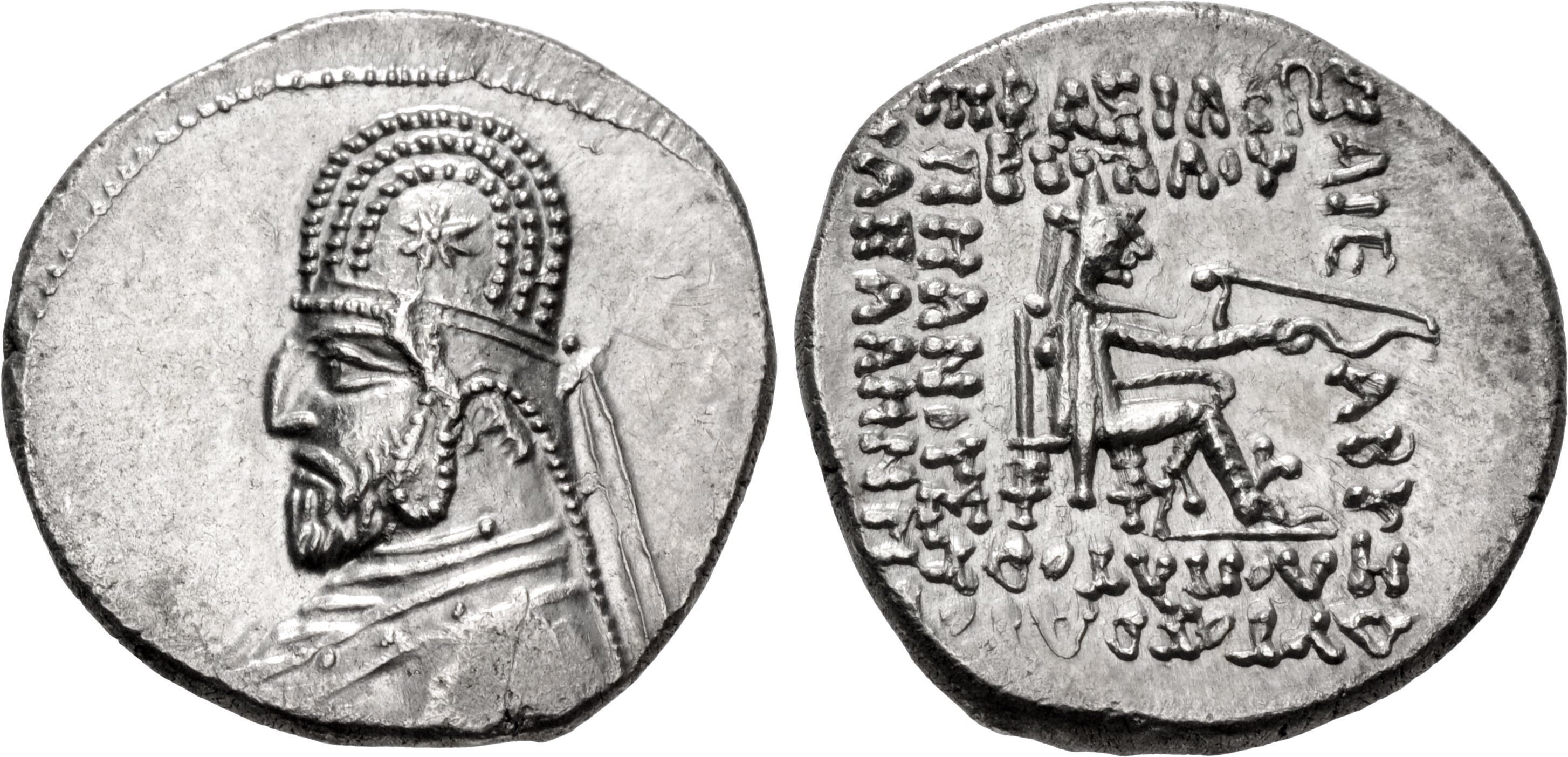S 1363 - Ecbatana (Mithridates III), silver, drachms (87-80 BCE)
From SILVER
87 BCE - 80 BCE Silver 1,021 kg
Description
| ObverseInscription or printing placed on the obverse.: | Bust of the king left, wearing diadem. Border of dots. |
| ReverseInscription or printing placed on the reverse.: | ΒΑΣΙΛΕΩΣ ΜΕΓΑΛΟΥ ΑΡΣΑΚΟΥ ΔΙΚΑΙΟΥ ΕΠΙΦΑΝΟΥΣ ΘΕΟΥ ΕΥΠΑΤΟΡΟΣ ΦΙΛΕΛΛΗΝΟΣ (Greek).King seated right, wearing diadem, holding bow. (In the left field, B). In the right field, A. |
Mint and issuing power
| MintIdentifies the place of manufacture or issue of a numismatic object.: | Ecbatana | Ancient regionAncient region.: | Media | Modern countryModern country: Iran | AuthorityIdentifies the issuing power. The authority can be "pretended" when the name or the portrait of X is on the coin but he/she was not the issuing power. It can also be "uncertain" when there is no mention of X on the coin but he/she was the issuing power according to the historical sources: | Parthian Empire, Mithridates III (king of the Parthian Empire, 87-80 BC) |
Chronology
| FromIdentifies the initial date in a range assigned in a numismatic context. | 87 BCE | toIdentifies the final date in a range assigned in a numismatic context.. | 80 BCE | PeriodTime period of the numismatic object.: Hellenistic 323-30 BC |
Physical description
| MetalThe physical material (usually metal) from which an object is made.: | Silver |
Median weightMedian of the weights of numismatic objects (in grams). in grams | 3.50 | DenominationTerm indicating the value of a numismatic object. Examples: tetradrachm, chalkous, denarius.: | drachm | StandardStandard.: |
Image

S1363 Ecbatana Mithridates III drachms.jpg [1]
References
| Die study referencePublication of the study: | Boillet 20091Boillet 2009, p. 311-316, n° 1520-1560 | ||
| Coin series referenceReference to coin series study: | Sellwood 19802Sellwood 1980, n° 35.1 (var.) | ||
Obverse dies distribution
| FrequencyFrequency of specimen in distribution. ᵖ | Number of obversesNumber of obverse dies. ᵖ (o) | % (o) | Number of coinsNumber of coins. (n) | % (n) | Die nameName(s) of the die(s). |
| 1 | 4 | 33.33 | 4 | 9.76 | 7, 8, 9, 10 |
| 2 | 3 | 25 | 6 | 14.63 | 3, 5, 11 |
| 3 | 1 | 8.33 | 3 | 7.32 | 12 |
| 4 | 1 | 8.33 | 4 | 9.76 | 6 |
| 5 | 1 | 8.33 | 5 | 12.2 | 2 |
| 10 | 1 | 8.33 | 10 | 24.39 | 1 |
| Total | 11 of 12 | 91.65 | 32 of 41 | 78.06 |
Reverse dies distribution
no distribution is available
Quantification
| Number of obversesNumber of obverse dies. ᵖ (o) | 12 | Number of singletons (o1)The number of singleton coins. ᵖ | 4 |
| Number of reverse diesNumber of reverse dies. (r) | 28 | Number of coinsNumber of coins. (n) | 41 |
| Coins per obverse dieNumber of coins per obverse die. (n/o) | 3.42 | Coins per reverse dieNumber of coins per reverse die. (n/r) | 1.46 |
| Reverse per obverse ratioRatio of obverse dies divided by reverse dies. (r/o) | 2.33 | Percentage of singletons (o1)number of coins (n) divided by the number of singletons (o1) ᵖ | 33.33 % |
| Original number of dies (O) (Carter 1983 formula)The estimation of the number of coins according to Carter 1983 ᵖ | 14.59 | Coins struck if 20,000 as average productivity per dieCoins made if the average productivity for obverses (according to Carter) is 20,000. ᵖ | 291,800 |
| Original number of dies (O) (Esty 2011 formula)The estimation of the number of coins according to the singleton formula in Esty 2011 ᵖ (O) | 16.97 | Survival rate if 20,000 as average productivity per dieSurvival rate if average productivity is 20,000. ᵖ | 0.00014 |
| Coverage (o = % of O) (Esty 1984 formula)Esty 1984 - coverage (% of O) ᵖ (o = % of O) | 90.24% | Die productivity if survival rate 1/2,000Average productivity if survival rate is 1/2,000. ᵖ | 5,620.29 |
| Weight of silver (in kg) if 20,000 coins per die (O = Carter formula)Carter 1983 * Median weight * 20000 (*10 if gold or electrum) ᵖ | 1,021 kg <br /> 1,021 kg | Die productivity if survival rate 1/5,000Average productivity if survival rate is 1/5,000. ᵖ | 14,050.72 |
Remarks
References
- ^ Boillet, Pierre-Yves (2009), Ecbatane et la Médie d’Alexandre aux Arsacides (c. 331 a.C. - c. 224 p.C.). Histoire monétaire et économique, unpublished doctoral dissertation, Bordeaux University.
- ^ Sellwood, David (1980), An introduction to the coinage of Parthia, 2nd ed., London, Spink & Son, 322 p., 10 pl.